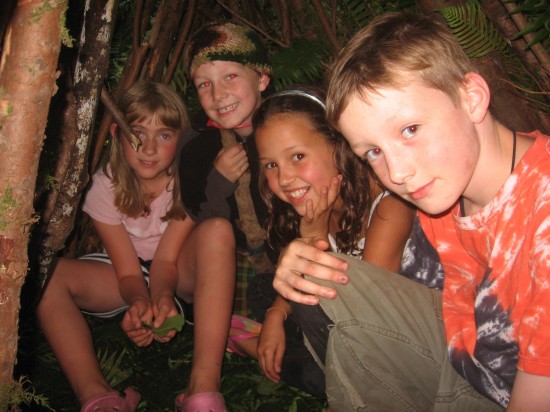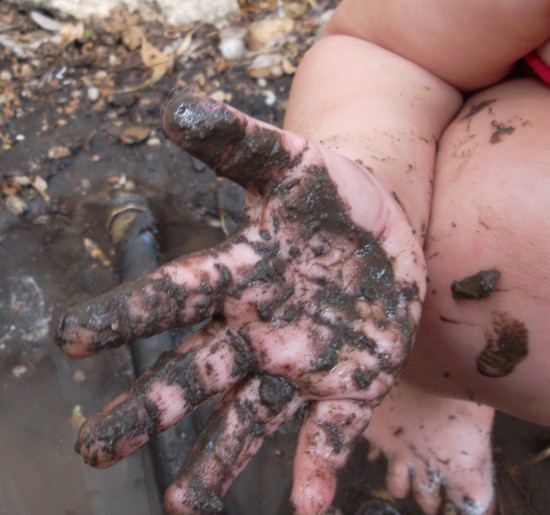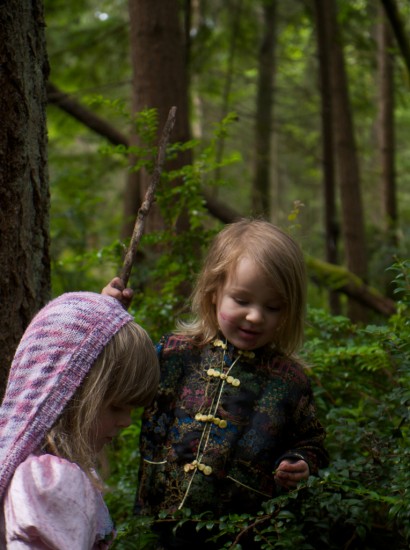Forest Schools and the Benefits of Unstructured Outdoor Play
 By Deanna Fahey
By Deanna Fahey
Miami University, Oxford, Ohio
![]() t is snowing outside and you’re getting your child ready to go to kindergarten. While other children may be wishing for a snow day so they can play in the snow, yours is excited to go to school! Why is your child unique? Your child attends a forest school. Forest schools and nurseries are popping up around the globe and gaining momentum. Though these schools have routines that are wide ranging, they all have a common core: allowing children to experience the freedom of playing outdoors as part of their learning.
t is snowing outside and you’re getting your child ready to go to kindergarten. While other children may be wishing for a snow day so they can play in the snow, yours is excited to go to school! Why is your child unique? Your child attends a forest school. Forest schools and nurseries are popping up around the globe and gaining momentum. Though these schools have routines that are wide ranging, they all have a common core: allowing children to experience the freedom of playing outdoors as part of their learning.
ROAD TO DISCOVERY
As a graduate student, parent and nature lover, I questioned why some adults choose to make decisions based on ecological consequences while others do not. After all, in today’s day and age, we all are aware of the consequences of our modern lives on the environment. On walks with our daughter, my husband and I spent numerous conversational hours chipping away at adult psyches trying to figure out an answer to this apparent quandary. There has to be some keystone event, I argued, in a person’s life that generates a concern for their environment as adults. During my questioning, I came across an answer. Through interviews, researchers have come to find that a direct, positive experience in nature before the age of 11 promotes a long-term connection to nature. However, given the state of today’s society, our children spend less and less time outside. What does that mean for our environmental future? It was during this time of questioning I was introduced to Erin Kenny, co-founder and lead teacher of Cedarsong Nature School. My husband had been watching Nightline when he called me in. There Kenny and parents were discussing the joys of sending their children to a forest school. I had to know more!
Friedrich Froebel opened the first kindergarten in Germany in 1837. The core of his curriculum integrated nature and play to provide children ages three to six a place to grow. Over time Froebel’s curriculum has morphed to become more academic in character and concern for children’s growth has been replaced by concern for preparation for elementary school. However, parents around the globe are uniting and fighting to bring nature back to their children. The result of this movement by parents is the reintroduction of forest schools.
Forest schools may fluctuate in their everyday routine but the core value of spending a majority of time engrossed in outdoor play remains the same. According to the American Academy of Pediatrics (Ginsburg, 2006), play is essential to the well-being of children. The varied terrain of nature stimulates imagination, encourages creativity, and builds motor skills. Undirected play allows children to learn to share, work in groups and negotiate. Children involved in play face and conquer fears while self-esteem is boosted as obstacles are worked out and overcome. Play is so important to the overall health and well-being of children it has been recognized by the United Nations High Commission for Human Rights as a right of every child (UNICEF).
In order for children to develop a love of nature, appropriate opportunities for interaction need to be provided. Too often in today’s society children know more about exotic flora and fauna from faraway places but have no idea of the beauty that lies right outside their own door. If children grow to adulthood with no love for, or worse yet a fear of, nature how can we expect them to become environmentally empathetic adults. According to White and Stoecklin (2008) children need to experience nature on a regular basis in order to develop pro-environmental values.
It was a clear morning as we drove through the forest on Vashon Island in Seattle. We were on the hunt for the elusive forest school. The sun glimmered off the dew hanging on the leaves, blinding us at times to the road ahead. Further and further we drove until at last we reached the end of the road. Where to from here though? Ah, just follow the sounds of the laughing children. We had reached Cedarsong Nature School. I was about to begin my journey into a school with no walls and where children lead the class instead of the teachers; a world virtually impossible for me to imagine but that I was eager to explore!
When I caught up with the children at Cedarsong, they were in the process of making some very delicious mud pies! The girls were covered head to foot in mud and they could not have been happier. They were standing in a circle chatting together over their work and discussing things only known to them. As I stood aside and watched, Erin Kenny, co-founder of Cedarsong, described to me how the children are the leaders of the day; their interests and observations dictate what will be learned. As a teacher myself, I questioned the logistics of this system. How does anything get covered when children decide what to learn? She told me how a random comment about tripping over a tree root can lead to a discussion on erosion and weather or the purpose of the roots of a tree to photosynthesis. The possibilities are endless! Changing seasons bring continual opportunities to track and record growth, and discuss hibernation and even death. New observations can lead to predictions, fallen trees and fungus can stimulate conversation on decomposition which can lead to discussions about habitats and niches. Teachers, it turns out, can just stand back and observe; it is from their observations that teacher’s take their cues of where to lead.
 A boy had decided to explore a bit more of the area; Kenny and I followed leaving the girls in safe sight of the teachers. As we followed the child further into the forest my “inner child” was awakened and I wanted nothing more than to climb the nearest tree or jump into one of the many puddles. My senses were stimulated by the sounds of the birds and insects calling out their warnings of strangers nearby and I desperately wanted to search out the sources of those warnings calls! However, I was there to observe the children and not to indulge my own inner child so I turned my attention back to the child we were shadowing.
A boy had decided to explore a bit more of the area; Kenny and I followed leaving the girls in safe sight of the teachers. As we followed the child further into the forest my “inner child” was awakened and I wanted nothing more than to climb the nearest tree or jump into one of the many puddles. My senses were stimulated by the sounds of the birds and insects calling out their warnings of strangers nearby and I desperately wanted to search out the sources of those warnings calls! However, I was there to observe the children and not to indulge my own inner child so I turned my attention back to the child we were shadowing.
Further along the path the child had found a tree to climb. Though Kenny moved a bit closer, she did not flinch or move to stop the boy. I inquired about fear of accidents given the freedom the children seem to be allotted. According to Kenny not many children do get hurt— they learn and respect their own limitations. On the rare occasion one does get hurt, there are emergency protocols that all teachers are familiar with. Teachers are certified and stay current in first aid and CPR. Kenny’s experiences with accidents are similar to those from forest schools in Europe.
Marga Keller is the founder of WaKiTa, a forest daycare located in Zurich, Switzerland. Keller stated, “Experience shows that in forest institutions fewer accidents happen than in mainstream schools.” She clarifies, explaining that because the teachers consciously learn how to handle risks with the children and help them strengthen their own skills, the children can assess risk situations better. The children also do not feel the need to rebel against overly restrictive rules or prove their courage because the school actually puts this as part of the program: the teachers offer the children age-appropriate challenges.
 Back with the main group, Kenny asked if anyone would like to lead a hike to show me the rest of the forest. All the children decided to go and we set off together. As we wandered through the forest, the children impressed me with their knowledge of the local plants and fungi. I was taken to forts and shelters camouflaged in the trees, the likes of which my own children would have gone crazy for! As we strolled on, the children dispersed to different areas of the trail and Kenny and I had another opportunity to discuss the school and the children’s role. “Children challenge themselves all the time in the outdoor setting,” Kenny told me. “They display great personal pride in their achievements.”
Back with the main group, Kenny asked if anyone would like to lead a hike to show me the rest of the forest. All the children decided to go and we set off together. As we wandered through the forest, the children impressed me with their knowledge of the local plants and fungi. I was taken to forts and shelters camouflaged in the trees, the likes of which my own children would have gone crazy for! As we strolled on, the children dispersed to different areas of the trail and Kenny and I had another opportunity to discuss the school and the children’s role. “Children challenge themselves all the time in the outdoor setting,” Kenny told me. “They display great personal pride in their achievements.”
Each day is unique and brings new sources of inquiry and excitement! Children learn to work together and cooperate through imaginative play. According to Burdette and Whitaker (2005), when children play outdoors there is more opportunity for problem solving and creative thinking. The varied terrain and multiple stimuli which nature provides deliver the perfect environment for imagination.
As my time came to an end at Cedarsong, I felt encouraged with all that I had seen. The possibilities for incorporation of nature into the American education system seemed endless and the benefits for our future generations infinite!
Bringing Back Outdoor Play
Forest schools may seem ideal for the issues I was grappling with, but not all of our schools and children have access to nature in their backyard. Urban schools are at a distinct disadvantage for this type of schooling; however, there are schools working on solutions which could be sustainable for all urban schools. For example, Muscota New School, located in New York City, utilizes Inwood Hill Park and Bear Mountain State Park, making the most of the nearby outdoor areas available to them.
According to the California Department of Education (2011), environment-based education employs natural ecosystems as a context for learning. The “environment” may be a river, a forest, a city park, or a garden carved out of an asphalt playground.
It seems any environment can be employed as an area for incorporating outdoor play, opening doors for practical outdoor play solutions.
You cannot turn on the news today without hearing about school funding issues; yet funding concerns can be overcome through partnerships, grants and community volunteer days. Taft Elementary School in Redwood City, California, partnered with Hidden Villa, a non-profit outdoor education organization to create their school garden program. CitySprouts, based in Cambridge, Massachusetts, partners with public schools to develop school gardens. Citysprouts also works to educate teachers on the integration of existing curriculum with their gardens. The Lorrie Otto Seeds for Education Grant Program provides grants for large scale projects such as the “design, establishment and maintenance of a native-plant community such as prairie, woodland, wetland, etc. in an educational setting such as an outdoor classroom.”
Modifications select schools are making to outdoor immersion are providing sustainable and worthwhile results. Our children are gaining access to the outdoors, attaching to nature and initiating positive change in their well-being.
WHERE DO WE GO FROM HERE?
Even though forest schools may not be the catch-all answer I was looking for, they can be a viable solution to our children’s lack of outdoor play and keystone moments. For those schools without a sizable amount of accessible land, compromises can be made. Vegetable gardens are being employed to reinforce geometry sills, nutrition, life science and basic math. An extension can include cultural differences in gardening techniques and vegetable preferences as well as recipes, which of course can be utilized for basic math. Trees found on school grounds can be used to teach geometry, prediction, microhabitat, and chemistry. An ecosystem extension can be incorporated by linking with international schools to compare tree data; growth rates, circumference, etc. (sites such as Jane Goodalls – http://www.rootsandshoots.org/ are perfect for this type of linking). Logs and larger branches on the ground can be used for agility, microhabitat, decomposition, nutrient recycling, chemistry, prediction and even physics. Why are branches of similar size but different trees weigh different? Water sources – even puddles after a rain – can be used for chemistry, prediction, water analysis and physics. Have you ever wondered about the force of a foot splashing in the water and the correlation to height of the splash? Cultural stories and knowledge can be shared while observing and studying local plants. I for one have always wondered about the ability of plants to break rocks as the seeds grow. Sounds like a perfect inquiry-led question for a physics class. Ant hills can be an endless source of amusement and knowledge for younger children learning about habitat. Decomposing leaves on your school grounds can become the perfect place to discuss microhabitat, nutrient recycling and niche. Of course the simplest solution would be to get rid of the cement playground and replace it with a natural playground, one complete with grass, fallen and living trees and butterfly and vegetable gardens.
In our world today adults are making choices that are counter-intuitive to what is best for our environment. Without contact with their natural world our modern children will grow up to be less inclined to save the earth than some of us seem to be today. As adults we need to come together and give our children the access to nature they deserve. With the constraints of today a feasible solution to this problem is to bring back outdoor play to our school children!
Reference:
Burdette, H. & Whitaker, R. (2005. Jan.). Resurrecting Free Play in Young Children: Looking Beyond Fitness and Fatness to Attention, Affiliation, and Affect. Arch Pediatr Adolesc Med. Vol. 159. Retrieved from www.archpediatrics.com at University of California – Berkeley
California Department of Education. (2011). School Garden Program Overview ; An overview of the school garden program including its impact on children’s health, nutrition, and academic achievement. Retrieved from http://www.cde.ca.gov/ls/nu/he/gardenoverview.asp
Citysprouts. http://www.citysprouts.org/
Ginsburg, K. (2006. May). Testimony of Kenneth Ginsburg, MS, MS Ed, FAAP on Behalf of the American Academy of Pediatricians. Natural Resources Subcommittee on National Parks, Forests and Public Lands and Subcommittee on Fisheries, Wildlife and Oceans. “No Child Left Inside: Reconnectiong Kids with the Outdoors”.
Keller, M. WaKiTa Outdoor Daycare
Kenny, E. Cedarsong Nature School
Moving Outdoors in Nature Act. Retrieved from http://www.govtrack.us/congress/billtext.xpd?bill=h111-6426
Muscota New School. http://www.muscota.org/
Rymer, B. (2009. December). Taft Elementary School’s Garden Program; A Case Study. Retrieved from http://www.redwoodcity.org/manager/initiatives/gardens/helpful/Taft%20Case%20Study%20Draft.pdf
The Lorrie Otto Seeds for Education Grant Program. http://www.for-wild.org/seedmony.html
White, R. & Stoecklin, V. (2008). Nurturing Children’s Biophilia: Developmentally Appropriate Environmental Education for Young Children. White Hutchinson Leisure & Learning Group
UNICEF. http://www.unicef.org/rightsite/files/uncrcchilldfriendlylanguage.pdf




We’re a bunch of volunteers and opening a new scheme in our community.
Your web site offered us with helpful info to work on. You’ve
performed an impressive process and our whole neighborhood will be grateful to you.
One of the best lessons children can be taught in their early years is to play outdoors. Children innately reap great benefits as they grow connection and appreciation of the natural environment. In the structured, busy and technologically-advanced world we live in, the role of outdoor play that we experienced as children is being forgotten.
This paper examines the values of the CHE principles of Connectivity, Humanness and Empathy as a guiding framework for maximizing the ethical and methodological advantages of semi-structured interview research practices. The authors draw from two separate educational studies and apply the CHE principles to analyse and evaluate the effectiveness of decision-making in facilitating sustainable relationships with the participants in each study. Findings highlight that dialogical relations with participants were evident in both studies, and identify significant junctures where decision-making and actions influenced effective rapport-building and respectful and reciprocal relationships with participants in the research. The CHE principles emerge as providing a robust framework for educational researchers to employ when auditing their decision-making prior to and during their engagement in qualitative interviews.